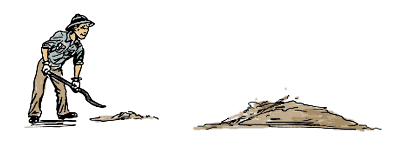Publications on Japanese Archaeology
This is a list of some of my publications on Japanese archaeology. It contains only publications in English or with significant English summaries. Most of these publications are available from the publishers, but many of them can be obtained directly from me.
Selected publications by myself and others are appended to each of the separate sections of topics in Japanese archaeology. Please refer to those for more information on English-language resources on the subject, as well as resources in Japanese and Russian.
- Patrick D. Nunn, Charles T. Keally, Caroline King, Jaya Wijaya, and Renato Cruz. (2006). Human Responses to Coastal Change in the Asia-Pacific Region. In: Nick Harvey, ed., Global Change and Integrated Coastal Management: The Asia-Pacific Region. Coastal Systems and Continental Margins, vol. 10. The Netherlands: Springer, pp. 117-161. (Asia-Pacific Network for Global Change Research, Kobe, Japan).
- Charles T. Keally. (2005). Academic Elitists and Elite Academics: An Essay. Sophia International Review, 28:97-104.
(on this web site)
- Charles T. Keally. (2004). "Fakery" at the Beginning, the Ending and the Middle of the Jomon Period. Bulletin of the International Jomon Culture Conference, 1:45-50 (Japanese translation: pp. 129-132).
(on another web site)
- Charles T. Keally, Yasuhiro Taniguchi, Yaroslave V. Kuzmin, and Igor Y. Shewkomud. (2004). Chronology of the Beginning of Pottery Manufacture in East Asia. Radiocarbon, 46(1):345-351.
- Charles T. Keally. (2004). Bad Science and the Distortion of History: Radiocarbon Dating in Japanese Archaeology. Sophia International Review, 26:1-16. (on this web site)
- Charles T. Keally, Yasuhiro Taniguchi & Yaroslav V. Kuzmin. (2003). Understanding the Beginnings of Pottery Technology in Japan and Neighboring East Asia. The Review of Archaeology, 24(2):3-14.
- Charles T. Keally & Natsumi Uryu. (2003). Archaeology as Seen in Popular Literature: Osamu Tezuka's Pheonix: The Yamato Story. Sophia International Review, 25:1-12.
- Charles T. Keally. (2002). Japan's Early-Palaeolithic Hoax and Two Sites. Current Research in the Pleistocene, 19:46-49.
- Charles T. Keally. (2002). Dirt and Japan's Early Palaeolithic Hoax. Sophia International Review, 24:33-41. (on this web site)
- Yaroslav V. Kuzmin & Charles T. Keally. (2001). Radiocarbon Chronology of the Earliest Neolithic Sites in East Asia. Proceedings of the 17th International 14C Conference, ed. I. Carmi & E.Boaretto. Radiocarbon, 43(2B):1121-1128.
- Charles T. Keally. (2001). One Interpretation of the Large Pillared Structures at the Sannai Maruyama Site, Aomori Prefecture. Tama Koko (The Archaeological Research in Tama District), 31:31-32. (in Japanese with English translation on this web site)
- TANIGUCHI Yasuhiro (trans. Charles T. Keally). (1999). Archaeological Research at the Odai Yamamoto I Site (English summary). Tokyo: Kokugakuin University, Odai Yamamoto I Iseki Hakkutsu Chosadan.
- Charles T. Keally. (1992). Japan's "Early Palaeolithic": A Changing Controversy. Current Research in the Pleistocene, 9:27-29.
- Charles T. Keally. (1991). Environment and the Distribution of Sites in the Japanese Palaeolithic: Environmental Zones and Cultural Areas. Bulletin of the Indo-Pacific Prehistory Association, no. 10, pp. 23-39.
- Charles T. Keally. (1990). The Third-millennium B.C. Uedomari 3 Site, Rebun Island, Hokkaido: Life at a Far Northern Outpost of the Ento Peoples from Tsugaru. Sophia International Review, 12:19-33.
- Charles T. Keally. (1990). Hokkaido Pleistocene Archeology and the Earliest Americans: Some Comments. Current Research in the Pleistocene, 7:143-146.
- Charles T. Keally, ed. (1990). Regional Focus: Hokkaido, Japan. Current Research in the Pleistocene, 7:141-164. (contains 8 separate articles, plus my introduction, given above)
- Charles T. Keally. (1988). Recent Advances in Pleistocene Archaeology in Northern Japan. Current Research in the Pleistocene, 5:13-15.
- Charles T. Keally. (1987). Spacial Patterning of Behavior in a Middle Jomon Village: the Yamanesakaue Site, Tokyo, Japan. Sophia International Review, 9:39-45.
- Charles T. Keally. (1987). Japan's "Early Paleolithic": Recent Pro and Con. Current Research in the Pleistocene, 4:19-20.
- Izumi Hayakawa & Charles T. Keally. (1987). The 30,000-year-old Lithic Components from the Musashidai Site, Tokyo, Japan. Current Research in the Pleistocene, 4:61-64.
- Charles T. Keally. (1986). Some Key Characteristics of Japanese Pleistocene Archaeology. Current Research in the Pleistocene, 3:94-95.
- Hiroshi Miyazaki & Charles T. Keally. (1986). A Terminal Pleistocene Salmon-fishing and Lithic Worksite at Maeda Kochi, Tokyo, Japan. Current Research in the Pleistocene, 3:96-97.
- Shizuo Oda & Charles T. Keally. (1986). A Critical Look at the Palaeolithic and "Lower Palaeolithic" Research in Miyagi Prefecture. Jinruigaku Zasshi, 94:325-361.
- Charles T. Keally. (1984). Unequal Privilege in Jomon Society, a Pilot Study. Sophia International Review, 6:34-42.
- Charles T. Keally. (1980). Japanese Archaeology in the 1970s. Sophia International Review, 3:28-39.
- Shizuo Oda & Charles T. Keally. (1979). Japanese Palaeolithic Cultural Chronology. Privately published monograph.
- Shizuo Oda & Charles T. Keally. (1973). Edge-ground Stone Tools from the Japanese Preceramic Culture. Busshitsu Bunka, 22:1-26.
- Charles T. Keally. (1972). The Earliest Cultures in Japan. Monumenta Nipponica, 27:143-147.
- Charles T. Keally. (1969). A Jomon Site at Ninomiya. Monumenta Nipponica, 24:249-258.
Top of Page
Here are the addresses of some of the publishers:
- Sophia International Review
- Faculty of Liberal Arts
Sophia University
7-1 Kioi-cho, Chiyoda-ku
Tokyo 102-8554, JAPAN
- Current Research in the Pleistocene
- CRP Editor
Center for the Study of the First Americans
Department of Anthropology
Texas A&M University
College Station, TX 77843-4352
U.S.A.
- Bulletin of the Indo-Pacific Prehistory Association
- Secretary IPPA
Department of Archaeology and Anthropology
Australian National University
Camberra ACT 0200
AUSTRALIA
- Monumenta Nipponica
- Monumenta Nipponica
Sophia University
7-1 Kioi-cho, Chiyoda-ku
Tokyo 102-8554, JAPAN
- Busshitsu Bunka
- Hakubutsukangaku Kenkyu-shitsu-nai
Rikkyo University
Nishi Ikebukuro 3-chome
Toshima-ku, Tokyo 171-0021
JAPAN

 )
(English web page)(Japanese)
)
(English web page)(Japanese) )
(web page)
)
(web page) )
) )
)